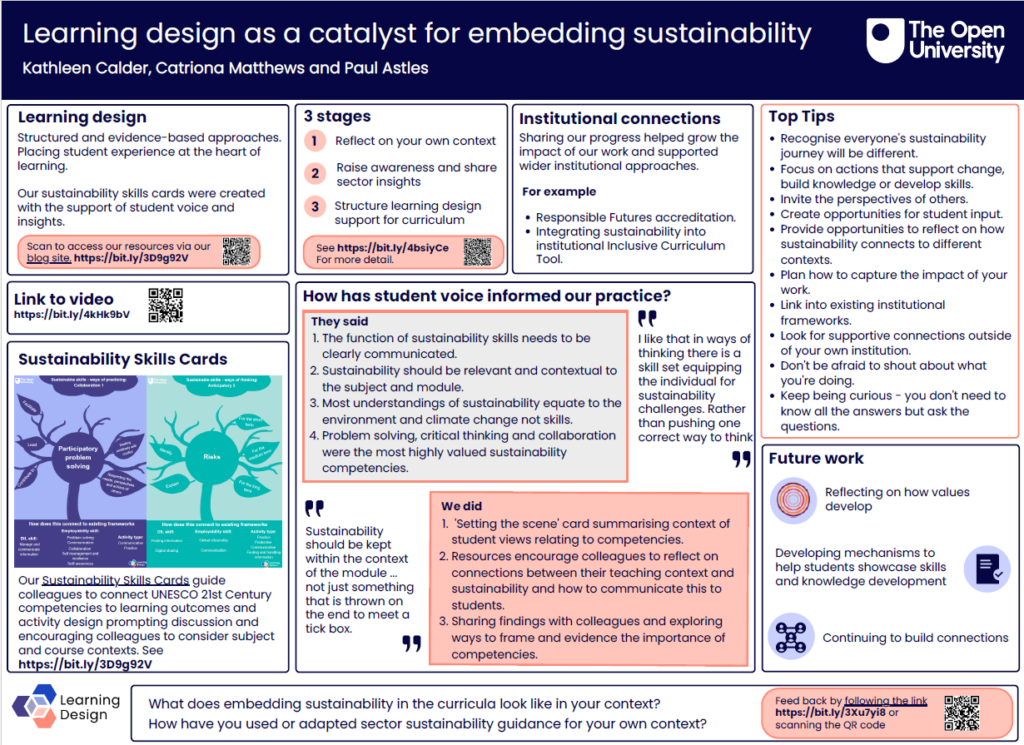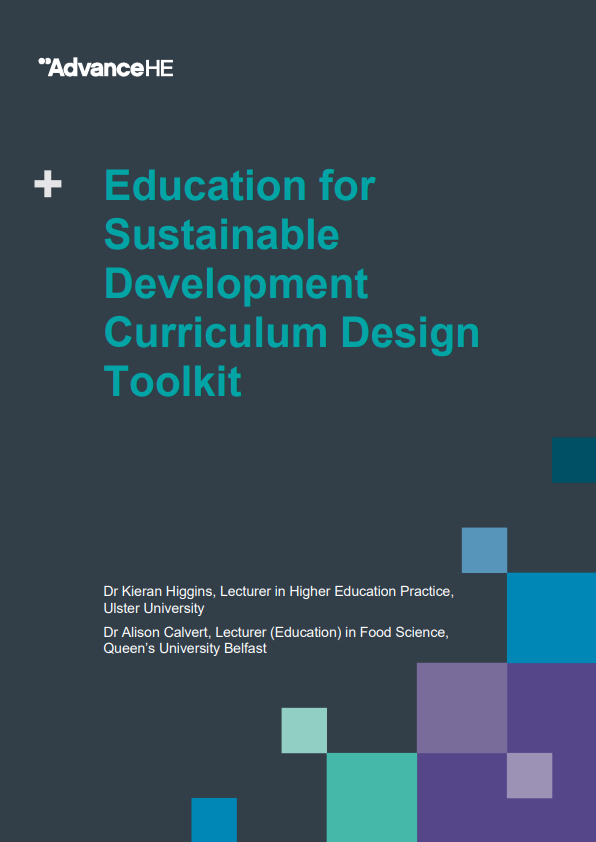Kathleen Calder SFHEA ~ Senior Learning Designer
In March I joined a panel to present our poster ‘Learning design as a catalyst for embedding sustainability’ at the AdvanceHE Sustainability Symposium. The poster describes some of the structured approaches the Learning Design Sustainability Group has taken to support embedding sustainability in curriculum design through connecting with wider institutional activity and embedding student voice. From awareness-raising through to the creation of OERs we’ve combined AdvanceHE/QAA UNESCO sustainability competencies with institutional frameworks and initiatives.

The symposium was a space to discuss practices and challenges in embedding education for sustainable development (ESD). Discussion included the challenge of how the focus of sustainability is often seen in terms of environmental sustainability, with further work needed to build understanding about the interconnectedness of environment, politics and society.
Our approach to embedding sustainability
Those actively involved in ESD have a shared understanding of what we think ‘sustainability’ means, but the terminology is unfamiliar to many people outside of that sphere, so we look for opportunities to sense-check our assumptions.
We’ve asked OU students and colleagues about their understanding and interpretation of ‘sustainability’ to find out what it means to them, to identify gaps and challenges, and to focus on where we can support and raise awareness.
To avoid overload, we seek to embed sustainability into existing initiatives. This includes connecting with EDIA, authentic assessment, student success initiatives, and course production strategies. We’ve created sustainability pages on our Learning Design intranet to share these examples and we talk to colleagues in other roles to encourage them to reflect on what sustainability might mean to them as individuals and in teams. Supporting this, we’ve looked for opportunities to contribute to groups across the University where sustainability can be represented and our learning design input can support institutional outcomes.
Insights from other institutions
I was able to attend several of the other workshops and sessions on the day, with useful insights from each. For more information about the sessions see the Sustainability Symposium website.
Integrating SDGs into postgraduate curricula
Prof. Kimberley Edwards and Dr Yasmin Nasir Ajanah from the University of Nottingham shared how they integrated Sustainable Development Goals (SDGs) into postgraduate curricula. Their approach was to assess staff knowledge and provide training and examples, focus on a few key SDGs, encourage cross-disciplinary collaboration and promote hands-on real-world relevance.
From London to Mauritius, how Education for Sustainable Development (ESD) is being embedded across a global campus
Dr Phil Barter, Dr Shaheen Motala-Timol, and Dr Tasneem Mustun from Middlesex University London and Mauritius shared how they had mapped all their programmes to graduate competencies and the UN SDGs to support ESD and development of the University’s strategic aims. This was achieved by explicitly embedding competencies and UN SDGs in the curriculum, authentic assessment, using formative assessment and reflection to provide opportunities for continuous learning, and providing personalised learning plans and sustainability skills development workshops.
Evaluating sustainability literacy: Seeking effective collaborative practice –
Dr Julie Gwilliam from Cardiff University shared work on the sustainability literacy of students and staff, asking them ‘what does sustainability mean to you?’ and considering how do we know the extent to which activity is having a tangible impact on students’ knowledge, competencies, actions and values? Their findings suggest that although awareness of sustainability may be high, there’s often a low capacity for the action needed for change. So how can we promote goal setting alongside confidence to act? They’re keen to work with other institutions to develop an open-source sustainability literacy evaluation tool.
A geographer, a poet and a political scientist walk into a classroom
Birkbeck shared their work on a taxonomy of approaches: 5 ways to embed environmental education, ranging from ‘cosmetic’ through to ‘collaboration’, taking an interdisciplinary approach.
Using experiential learning to engage students in interdisciplinary education for sustainable development
Dr Scott Strachan, University of Strathclyde, shared their vertical integrated project (VIP) project for sustainable development – using experiential learning to engage students in interdisciplinary ESD over time. Vertical integration is across years of study with a focus on active learning. Interdisciplinary study provides horizontal integration. The UNESCO competencies and behavioural domains of head, heart and hands, and the related SDGs, are articulated to students working on these projects over a period of time. The approach supports students from different disciplines to work on sustainability projects together, mapped onto SDGs, towards practical and tangible outputs.
The challenge of articulating competency development was raised throughout the symposium, and Scott shared how in the VIP project evidence was collected through:
- Frequent opportunities for reflection and peer feedback
- Scaffolded support in using the ‘STAR’ reflection structure to help students understand how they are using and developing skills as they go
- STAR practice and competency workshops scheduled into the study calendar
- Helping students track, value and articulate how the competencies were being developed through their journey
- Evidencing the project’s own efficacy in developing competencies in students
One year as an education for sustainable development officer
Barry Peake from Dublin City University shared his experience as an Education for sustainable development officer, discussing challenges and key features of the role, and engaging us in an activity identifying how to make an impact with stakeholders. We discussed how we can move from pockets of practice to a more integrated approach through:
- Developing an internal VLE course open to academic and professional staff
- Developing a digital badge in Education for Sustainability
- Providing workshops for groups of staff
- Ideas exchange and supporting communities of practice
Launch of the ESD curriculum design toolkit
A highlight of the symposium was the launch of the ESD toolkit by Dr Kieran Higgins and Dr Alison Calvert. This aims to support educators to enhance their teaching with sustainability competencies aligned to the UN SDGs and provides templates to use in planning authentic competency-based learning experiences through a 5-phase process. More information and download.

A final thought
Shared issues resonated with many of the experiences we’ve encountered in Learning Design, in particular:
- The understanding of ‘sustainability’ by students and staff
- Identifying routes to connect with people who have different understandings of sustainability or hold different priorities and values
- Being aware of overloading busy colleagues and students
- Evaluating impact – what does this mean, and for who? Are we looking for behaviour change or evidence of skills development?
It was interesting hearing where people were at on their journey and reassuring that our experience is similar to others in the sector. We know that working collaboratively can make a bigger impact in this area and would love to hear about initiatives or tips for embedding ESD that you can share.
You can discover more about our sustainability resources in the section for Sustainability Resources on our Learning Design blog.
More information on sustainability at the OU.
To speak to us about our journey or to learn more about our approach please feel free to contact us at LDS-LearningDesign@open.ac.uk.
Banner image via Canva/Fahroni.

